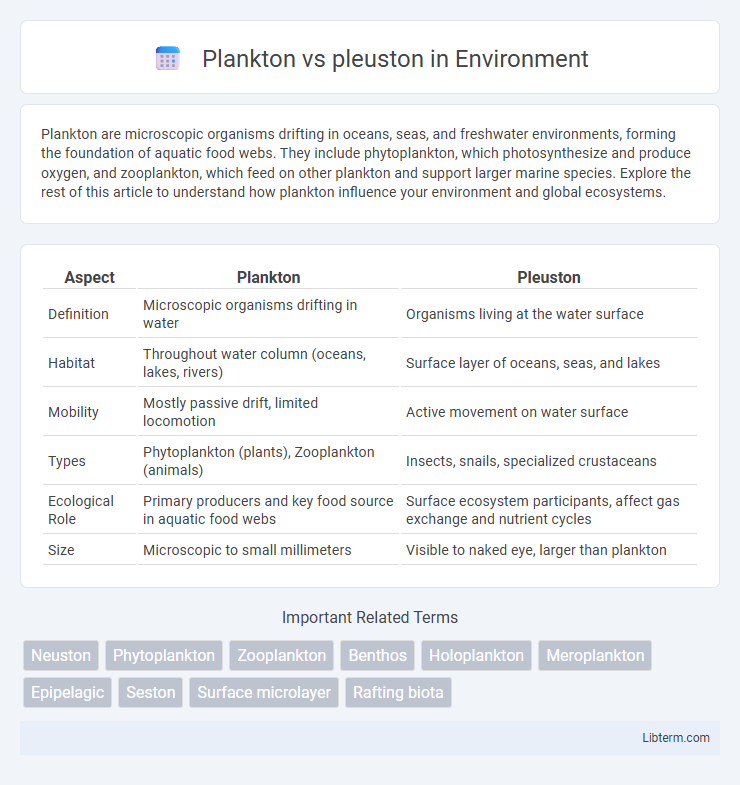Plankton are microscopic organisms drifting in oceans, seas, and freshwater environments, forming the foundation of aquatic food webs. They include phytoplankton, which photosynthesize and produce oxygen, and zooplankton, which feed on other plankton and support larger marine species. Explore the rest of this article to understand how plankton influence your environment and global ecosystems.
Table of Comparison
| Aspect | Plankton | Pleuston |
|---|---|---|
| Definition | Microscopic organisms drifting in water | Organisms living at the water surface |
| Habitat | Throughout water column (oceans, lakes, rivers) | Surface layer of oceans, seas, and lakes |
| Mobility | Mostly passive drift, limited locomotion | Active movement on water surface |
| Types | Phytoplankton (plants), Zooplankton (animals) | Insects, snails, specialized crustaceans |
| Ecological Role | Primary producers and key food source in aquatic food webs | Surface ecosystem participants, affect gas exchange and nutrient cycles |
| Size | Microscopic to small millimeters | Visible to naked eye, larger than plankton |
Introduction to Plankton and Pleuston
Plankton are small organisms drifting in water columns, classified into phytoplankton (photosynthetic) and zooplankton (animal-like). Pleuston refers to organisms living at the air-water interface, adapted to float or remain suspended. Both play crucial ecological roles in aquatic food webs and nutrient cycling.
Defining Plankton: Types and Characteristics
Plankton comprises diverse microscopic organisms drifting in aquatic environments, primarily categorized into phytoplankton (photosynthetic) and zooplankton (animal-like). These organisms possess limited mobility, relying on water currents for movement, and play a crucial role in aquatic food webs and carbon cycling. Characterized by their small size and widespread distribution, plankton species vary greatly in form, function, and life cycle dynamics, distinguishing them from the neustonic pleuston that inhabit the water surface interface.
Understanding Pleuston: Features and Examples
Pleuston refers to a diverse community of organisms living at the air-water interface of aquatic environments, distinct from plankton primarily found submerged within the water column. Key features of pleuston include their adaptation to both aerial and aquatic conditions, such as water-repellent body structures and specialized locomotion methods exemplified by the water strider and the Portuguese man o' war. Understanding pleuston highlights their ecological role in nutrient cycling, surface tension regulation, and serving as a habitat for microorganisms, contrasting with plankton's role in primary production and food webs below the surface.
Habitat Differences: Where Plankton and Pleuston Live
Plankton inhabit the entire water column, drifting freely in oceans, seas, and freshwater bodies from the surface to deeper layers. Pleuston reside at the air-water interface, occupying the very surface film of marine and freshwater environments. This distinct habitat separation influences their ecological roles, with plankton adapting to various depths while pleuston thrive in the unique niche between air and water.
Ecological Roles in Aquatic Ecosystems
Plankton, consisting of microscopic organisms like phytoplankton and zooplankton, serves as the foundational food source in aquatic ecosystems, driving primary production and supporting higher trophic levels, including fish and marine mammals. Pleuston, organisms living at the air-water interface such as certain insects and floating plants, contribute to nutrient cycling and provide unique habitats that enhance biodiversity and energy transfer between aquatic and terrestrial ecosystems. These contrasting ecological roles highlight the importance of both planktonic and pleustonic communities in maintaining ecosystem stability and productivity.
Adaptations to Environmental Conditions
Plankton exhibit adaptations such as buoyancy regulation through lipid storage and slow sinking rates to thrive in varying water columns, optimizing nutrient absorption and photosynthesis. Pleuston organisms possess specialized structures like waxy coatings and air sacs enabling them to float and resist desiccation at the air-water interface, surviving intense UV exposure and wave action. These distinct adaptations reflect evolutionary responses to their respective habitats, ensuring survival amid fluctuating salinity, temperature, and light conditions.
Importance in Food Webs
Plankton, including phytoplankton and zooplankton, form the foundational base of aquatic food webs by serving as primary producers and key primary consumers, supporting diverse marine and freshwater ecosystems. Pleuston, organisms inhabiting the air-water interface, play a crucial role in connecting aquatic and aerial food webs by providing a unique habitat that supports specialized predators and contributes to nutrient cycling. Both plankton and pleuston sustain higher trophic levels such as fish, seabirds, and marine mammals, highlighting their importance in maintaining ecosystem productivity and stability.
Notable Species: Plankton vs Pleuston
Notable plankton species include diatoms, copepods, and jellyfish larvae, which drift within water columns and play critical roles in aquatic food webs. Pleuston species such as the Portuguese man o' war, Velella velella, and Halobates, live at the air-water interface and are adapted to float on or near the ocean's surface. These distinct groups contribute uniquely to marine ecosystems, with plankton mostly inhabiting subsurface layers and pleuston specialized for life at the surface film.
Human Impacts and Conservation Concerns
Human activities, including pollution, climate change, and coastal development, severely disrupt plankton populations and pleuston ecosystems, altering food webs and carbon cycling. Overfishing and nutrient runoff exacerbate these impacts by promoting harmful algal blooms that threaten biodiversity and water quality. Conservation efforts emphasize reducing pollutants, monitoring ecosystem health, and protecting critical habitats to safeguard plankton and pleuston vital for oceanic carbon sequestration and marine food chains.
Key Differences: Plankton vs Pleuston Summary
Plankton are small organisms that drift in the water column, including phytoplankton (plant-like) and zooplankton (animal-like), primarily inhabiting various depths within oceans and freshwater. Pleuston consists of organisms living at the air-water interface, such as velella and physalia, adapted to float partially exposed to both air and water. The key difference lies in habitat: plankton drift submerged within the water body, while pleuston occupy the surface layer where they interact directly with both aerial and aquatic environments.
Plankton Infographic

 libterm.com
libterm.com